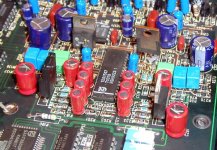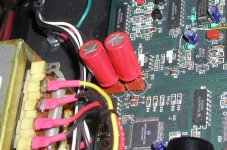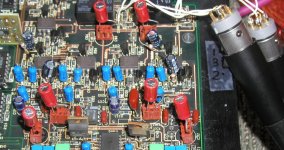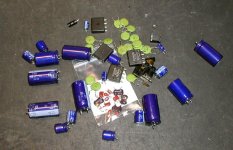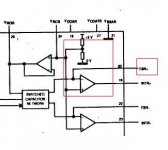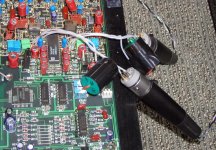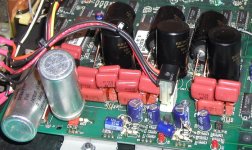Peter Daniel said:There are 3 more cap pairs on main filtering, and here nothing was really good, except for BG N 1000/50. Those caps are pretty expensive, at $60/pc, but working on greatest DAC of all times cannot be budget limited, if you know what I mean 😉
It was also pretty easy to implement them here.
I am eating this up! Thanks for sharing.
FYI all, here's the BiDAT mods history, as performed by John at Museatex:
The "Super Mod"
The Bidat was originally designed with 3 separate crystal-based voltage controlled oscillators. This was unique because we had the crystals specially made to be 'pull-able' around the sample rates of 33, 44.1 and 48 KHz. This scheme worked well only if the signal coming from the digital source was within the S/PDIF spec. In real life, many sources are not. The "super-mod" gets rid of these crystals and replaces the front-end PLL with another Meitner innovation - one that allows the Bidat to track the input even if the digital source is off-spec. The super mod is an extensive upgrade. In addition to the above, it includes changes to the power supply, power inlet, digital front-end and analog outputs. The cost of this update is $250.00 USD.
The Bidat "Plus" Update
This is it! This is the update that puts the Bidat back on top, if it ever slipped. This update will make your Bidat the best sounding converter on the planet. The analog stage has been revised as has the power supply decoupling and the lock detection circuitry. More importantly, the DAC chip is modified to run in a much more linear fashion with lower distortion. The result is a breath taking experience. The bass rolls out at you now with a tremendous sense of foundation. The sound stage is absolutely life like and the subtle inner detail is beyond description.
The Bidat Switching Power Supply
This update is no longer available.
(Updates are performed on Meitner and Museatex products at our Calgary facility.
Email us at john@museatex.com or call (403) 284-0723 for more information.)
There are two bypass caps in input section, I'm not sure what they really do, but they influence the sound substantially.
I tried Oscons, Cerafines, Rubycons, BG STD, BG FK, Nichicons, and I really didn't like any of them, the tonal balance was never right. I liked BG N the most, but even with them the highs, were somewhat subdued. I left them in though (47u BG N). Only after I removed input coupling transformer, it started to sound properly (the right amount of air and openness).
I tried Oscons, Cerafines, Rubycons, BG STD, BG FK, Nichicons, and I really didn't like any of them, the tonal balance was never right. I liked BG N the most, but even with them the highs, were somewhat subdued. I left them in though (47u BG N). Only after I removed input coupling transformer, it started to sound properly (the right amount of air and openness).
Attachments
There are 6 bypass caps around output chips. The usual mod includes BG FK 220uF caps here. I never liked FK caps as they seem like a compromise between STD and N grade, trying to provide benefits of N type cap at the budgetary price. To me, FK cap is colored and not useful. I either go with STD or N.
The original value here was Panasonic SU 470/16. I started with BG N 100/50 but the sound was "fat", not detailed and sort of "heavy". Changing to BG N 47/50 was not much improvement. BG N 10/50 was better, but a bit "thin". Eventually, I settled on Bg N 33/16 and it seems like the right cap for the job: it's clean sounding, fast enough, and provides level of immediacy I was missing previously.
I also tried Elna Cerafine 470/25, but it was totally wrong cap, when listening to certain recordings, the ringing was so strong that almost painful.
Please note the sockets I'm using when testing caps, it is easy way to swap them without the need for soldering. Also, notice the temporary XLR output connection, it simplifies removal of the baord from chassis (and I already did it at least 30 times 😉)
The original value here was Panasonic SU 470/16. I started with BG N 100/50 but the sound was "fat", not detailed and sort of "heavy". Changing to BG N 47/50 was not much improvement. BG N 10/50 was better, but a bit "thin". Eventually, I settled on Bg N 33/16 and it seems like the right cap for the job: it's clean sounding, fast enough, and provides level of immediacy I was missing previously.
I also tried Elna Cerafine 470/25, but it was totally wrong cap, when listening to certain recordings, the ringing was so strong that almost painful.
Please note the sockets I'm using when testing caps, it is easy way to swap them without the need for soldering. Also, notice the temporary XLR output connection, it simplifies removal of the baord from chassis (and I already did it at least 30 times 😉)
Attachments
BiDAT versions...
FWIW, my BiDAT allegedly has all the Museatex updates, so is the latest manufaturer version.
Photos are in this earlier post:
http://www.diyaudio.com/forums/showthread.php?postid=900408#post900408
-Rob
Peter Daniel said:
Maybe you could post some pictures of more recent stock?
FWIW, my BiDAT allegedly has all the Museatex updates, so is the latest manufaturer version.
Photos are in this earlier post:
http://www.diyaudio.com/forums/showthread.php?postid=900408#post900408
-Rob
The DAC sounds much better now than originally, there is actually no comparison. Gone is the veil and lack of immediacy and I actually find myself tapping the toes quite often 😉. It is still not really great, but much more listenable and I don't have problems using it on permanent bases.
It's still a long way before modding ends, but I have the feeling that what Romy is writing about that DAC on his site may actually be true 😉
Below are the parts I removed so far. Next thing I will be testing soon is the reguirement of snubbers on transformers secondaries and the need of bypass caps on rectifiers
It's still a long way before modding ends, but I have the feeling that what Romy is writing about that DAC on his site may actually be true 😉
Below are the parts I removed so far. Next thing I will be testing soon is the reguirement of snubbers on transformers secondaries and the need of bypass caps on rectifiers
Attachments
Re: BiDAT versions...
That what I thought too, but the guy sounded like he might have worked with Meitner at one time 😉
Rob Thomas said:FWIW, my BiDAT allegedly has all the Museatex updates, so is the latest manufaturer version.
That what I thought too, but the guy sounded like he might have worked with Meitner at one time 😉
Peter Daniel said:
Please note the sockets I'm using when testing caps
I also notice your BiDAT is rusty.

Rusty is only the transformer's cover, but I don' think it should bias my impression on the sound.
After listening for couple hours more, I can clearly state that the romoval of the input coupling transformer is the must in any Bidat (providing your transport is of reasonable quality).
After listening for couple hours more, I can clearly state that the romoval of the input coupling transformer is the must in any Bidat (providing your transport is of reasonable quality).
Re: BiDAT versions...
Correction, John Wright of Museatex has informed me that my BiDAT does NOT have the Plus update, which has been offered as of 2003 and is reportedly "pretty big".
-Rob
Rob Thomas said:
FWIW, my BiDAT allegedly has all the Museatex updates, so is the latest manufaturer version.
Correction, John Wright of Museatex has informed me that my BiDAT does NOT have the Plus update, which has been offered as of 2003 and is reportedly "pretty big".
-Rob
DAC 7
The 1547 typically has one great limitation; the internal op-amp.
But luck is that you can tap the DAC-chip in front of the op-amp...
Arne K
The 1547 typically has one great limitation; the internal op-amp.
But luck is that you can tap the DAC-chip in front of the op-amp...
Arne K
Re: DAC 7
Arne K,
Do you own a BIDAT ?
As for the tap of the SAA7350 DAC chip (instead of tda1547) are pins 20, and 22 the taps?
Sounds like a nice project for the Marantz cd52 MKII!
Cobra2 said:The 1547 typically has one great limitation; the internal op-amp.
But luck is that you can tap the DAC-chip in front of the op-amp...
Arne K
Arne K,
Do you own a BIDAT ?
As for the tap of the SAA7350 DAC chip (instead of tda1547) are pins 20, and 22 the taps?
Sounds like a nice project for the Marantz cd52 MKII!
Attachments
Re: Re: DAC 7
Nope, have had a Teac, + Marantz CD-14 & CD-16 with TDA1547
Arne K
ash_dac said:
Arne K,
Do you own a BIDAT ?
As for the tap of the SAA7350 DAC chip (instead of tda1547) are pins 20, and 22 the taps?
Sounds like a nice project for the Marantz cd52 MKII!
Nope, have had a Teac, + Marantz CD-14 & CD-16 with TDA1547
Arne K
Re: DAC 7
I'm actually quite interested in trying that approach, that would be just a single opamp for I/V conversion (internal DAC op amp not used) and signal fed directly into S&B TX102 line stage.
I'm considering OPA627 for that purpose, did you try other chips?
Cobra2 said:The 1547 typically has one great limitation; the internal op-amp.
But luck is that you can tap the DAC-chip in front of the op-amp...
I'm actually quite interested in trying that approach, that would be just a single opamp for I/V conversion (internal DAC op amp not used) and signal fed directly into S&B TX102 line stage.
I'm considering OPA627 for that purpose, did you try other chips?
I had plans...
But sold the CD-16 & Teac VRDS-10 in favor of a VRDS-25, the CD-14 was modded to death long ago...(still have the DAC/mainboard...).
Arne K
But sold the CD-16 & Teac VRDS-10 in favor of a VRDS-25, the CD-14 was modded to death long ago...(still have the DAC/mainboard...).
Arne K
Idat
Hi,
http://www.museatex.com/idat44.htm#idatUpdate
Any ideas which continuous calibrartion dac is used in the IDAT44 ?
Were MuseaTex products ever distributed in the UK ?
Hi,
http://www.museatex.com/idat44.htm#idatUpdate
Any ideas which continuous calibrartion dac is used in the IDAT44 ?
Were MuseaTex products ever distributed in the UK ?
Yesterday, I decided to run the DAC directly off the built in op amps. There is approx 40mV of differential voltage between both sides of a balanced signal, so I used 0.1uF V-Cap in series with one leg. The connection to output stage was separated by removing 4pcs of 5k6 coupling resistors. The balanced signal was fed directly into S&B TX102 line stage.
This is by far the best sound I'm getting from BiDAT. It is very relaxed, detailed, with amazing space, immediacy and stress free feeling one gets when using (unmodified) onboard output stage.
There is a slight trace of some sort of hazing and I'm not completely sure where it's coming from, but still more mods to be performed.
It seems like the coupling transformer was connected in phase inverting way. After removing it and reconnecting the traces, the signal seem to be in opposite phase than with transformer. I presently have phase adjusted, with front panel switch.
This is by far the best sound I'm getting from BiDAT. It is very relaxed, detailed, with amazing space, immediacy and stress free feeling one gets when using (unmodified) onboard output stage.
There is a slight trace of some sort of hazing and I'm not completely sure where it's coming from, but still more mods to be performed.
It seems like the coupling transformer was connected in phase inverting way. After removing it and reconnecting the traces, the signal seem to be in opposite phase than with transformer. I presently have phase adjusted, with front panel switch.
Attachments
Yesterday I approachd the bypass caps across rectifiers. Originally 0.1uF ceramics have been installed here. I removed them as first thing and subsequent mods have been done without those caps present. However, from my experience with ML31.6, I knew that there might be an improvement in some cases (like in ML31.6 for instance).
So, I tried with polypropylene Panasonics first (best grade from D-K). My initial impression was of very subdued sound, with presence, immediacy and air pushed to second plan. I didn't really like it and tried orange Philips caps. Those worked better, but still not to my satisfaction.
Then, I thought about removing the caps from the bridges used in analog supply and try them in digital section only.
And this was much better.
The signature of the caps is very well percived in that location, each cap sounded differently, having specific signature. I still didn't figure out if I prefer digital section with bypass caps or not. Without caps, the sound is more sharp and better defined. It is more direct and immediate. With the caps, the edges are somewhat rounded, the sound is smoother, with a definition that in its own way is also interesting.
I definitely didn't like ERO MK1937 here. Those are metalized foil. Same cap, in metal foil version (1830) was much better, with smoother presentation. Panasonic polypropylene is even smoother, but a bit much affecting highs (the signature actually similar to what FC caps do). The orange Philips pretty good overall, a bit rough maybe.
So, I tried with polypropylene Panasonics first (best grade from D-K). My initial impression was of very subdued sound, with presence, immediacy and air pushed to second plan. I didn't really like it and tried orange Philips caps. Those worked better, but still not to my satisfaction.
Then, I thought about removing the caps from the bridges used in analog supply and try them in digital section only.
And this was much better.
The signature of the caps is very well percived in that location, each cap sounded differently, having specific signature. I still didn't figure out if I prefer digital section with bypass caps or not. Without caps, the sound is more sharp and better defined. It is more direct and immediate. With the caps, the edges are somewhat rounded, the sound is smoother, with a definition that in its own way is also interesting.
I definitely didn't like ERO MK1937 here. Those are metalized foil. Same cap, in metal foil version (1830) was much better, with smoother presentation. Panasonic polypropylene is even smoother, but a bit much affecting highs (the signature actually similar to what FC caps do). The orange Philips pretty good overall, a bit rough maybe.
Attachments
After 2 days of listening, I'm pretty much tempted to remove the caps across the diodes in digital supplies as well.
ERO1830 0.01uF seemed to work best, but even those introduced certain veiling which seems too much of a trade off for smoothness. With the caps, the sound is loosing its "freshness", when they are removed, it's like the last curtain is lifted and gains in dimentionality are well perceived. The instruments suddenly have their own space, the sounds are _really_ 3-dimentional with layers of plans much better defined.
I started voicing the circuit without those caps in a first place, it may be different if someone does it with the caps across the diodes. It is possible that removing them then, has no advantage at all.
ERO1830 0.01uF seemed to work best, but even those introduced certain veiling which seems too much of a trade off for smoothness. With the caps, the sound is loosing its "freshness", when they are removed, it's like the last curtain is lifted and gains in dimentionality are well perceived. The instruments suddenly have their own space, the sounds are _really_ 3-dimentional with layers of plans much better defined.
I started voicing the circuit without those caps in a first place, it may be different if someone does it with the caps across the diodes. It is possible that removing them then, has no advantage at all.
I found polycarbonate worked well for this application, in a power amp though, maybe the smaller physical construction helps?
Polycarb has been phased out by most manufactureres, but you could try Wima SMD PPS (Polyphenylene-Sulphide) might be able to fit them on the back your rectifier daughter boards?
Regards
James
Polycarb has been phased out by most manufactureres, but you could try Wima SMD PPS (Polyphenylene-Sulphide) might be able to fit them on the back your rectifier daughter boards?
Regards
James
- Home
- Source & Line
- Digital Source
- BiDAT/Meitner/MuseaTex/
